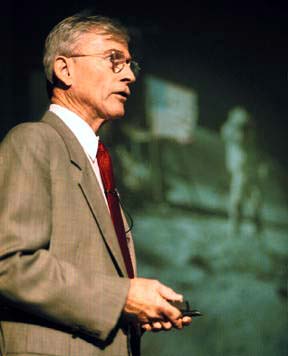
|
Astronaut John Young, in
front of an image of himself on the moon in 1972, talks to an audience at
the Sam Houston State University Killinger Auditorium Tuesday night.Richard Nira/Huntsville Item Photo |
The unassuming NASA senior related his story with humor and honesty, acknowledging
that his "knees were shaking" as the giant rocket on which his tiny spacecraft
was perched rumbled into space in 1972.
Young's mission these days is to bring a message of concern about catastrophic
events "that could change the Earth and humankind as we know it forever,"
he said.
"The last 25 years of NASA's Solar System exploration program is telling
us what we need to do to preserve our species," Young has written. "This
new knowledge is useless unless we act on it.
"NASA is not about just about the "Adventure of Human Space Exploration,'"
says Young, who is associate director of the Johnson Space Center south of
Houston. "We are in the deadly serious business of saving the species."
The planet itself is very tough, the former NASA astronaut said Tuesday.
It has withstood impact hits from very large meteorites; volcanic eruptions
that threw enough material into the atmosphere to lower the temperature below
freezing worldwide; and intense radiation from solar anomalies.
However, Young said, the animal and plant life that occupies the planet
is not so tough. He related that there have been three or four catastrophes
in the history of the planet that have resulted in mass extinction of different
species.
Young believes mankind needs to organize its technical resources so that
our species can either survive such catastrophes; avoid them; or evacuate
to another planet if necessary.
The threat as dramatized in movies such as "Armageddon" and "Sudden Impact"
are real, Young said, "but the science the movies presented was wrong."
The odds are 1 in 2,000 that that sometime in the next 50 years a kilometer
size meteor will hit the earth. That could wipe out one-third of the earth's
population, he said.
Young believes NASA knows what has to be done to live and work on the moon
and Mars. Such concerns include power, food production, closed loop environments
in which everything humans eat, drink and breathe is recycled, and how to
get there and back, or beyond.
He sees the challenge now, for himself and others who advocate the continuation
of space exploration by humans, in overcoming public apathy and ignorance.
Young was asked:
"How soon can we go to Mars?"
"Ten years after the President decides we're going," he said.
Q: What was his greatest accomplishment?
"When Susie and I got married," he answered. "That was my smartest move."
Q: Were you changed spiritually after your first space flight?
"No. I was crazy when I went up, and I was crazy when I came back."
Q: Would he go back into space?
"I would, but Susie says she would kill me if I did."
Young's sixth and last space flight was as commander of the first Spacelab
mission, which lasted for 10 days in November and December of 1983.
He said that mission produced more scientific and technical data than all previous Apollo and Skylab missions combined.
Today, Young attends to his Johnson Space Center duties, travels the world
as NASA's most accomplished active astronaut, and warns of the danger of
planet altering catastrophic events that have happened before ... and that
are almost certain to eventually happen again to Earth and its inhabitants.
Other distinguished lecturers who have participated in the SHSU distinguished
lecturer series, since the inception of the program in 1980 include, Polish
President Lech Walesa, former President George Bush, historian Arthur Schlesinger,
and economist John Kenneth Galbraith.
| 


